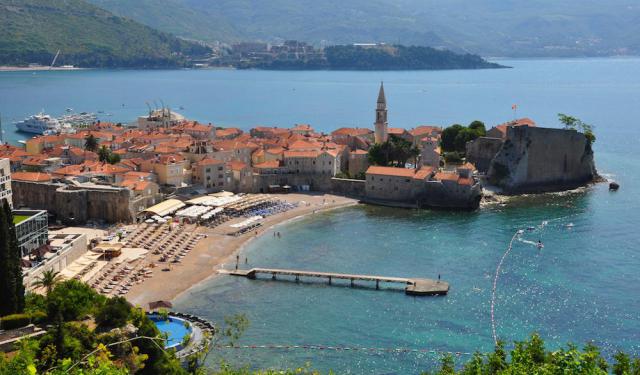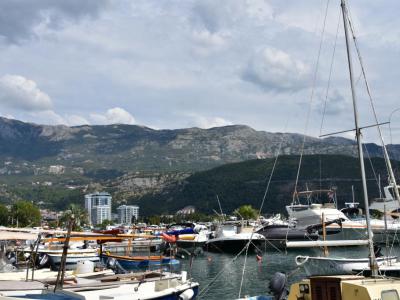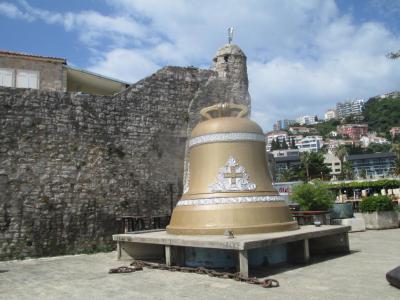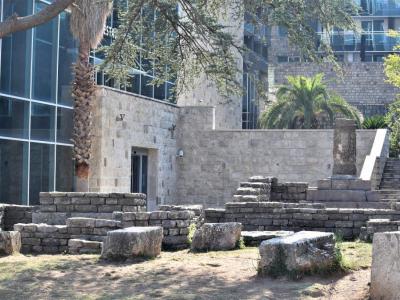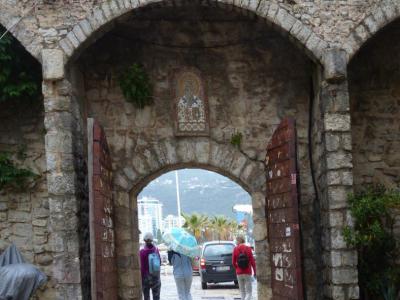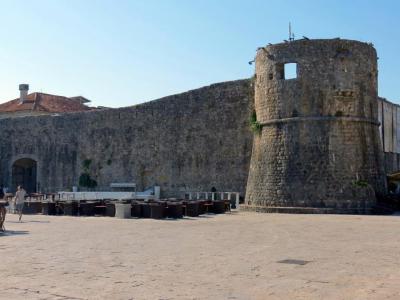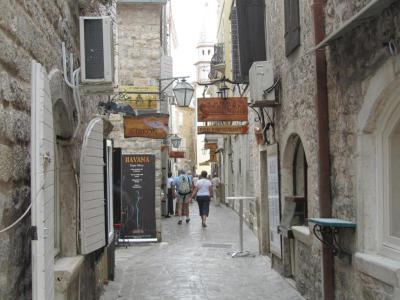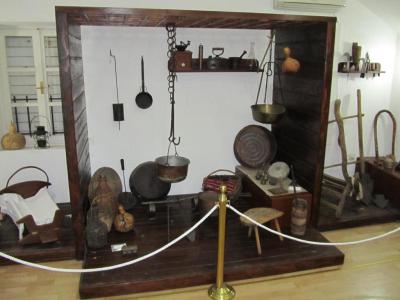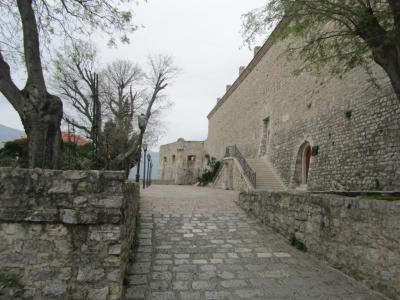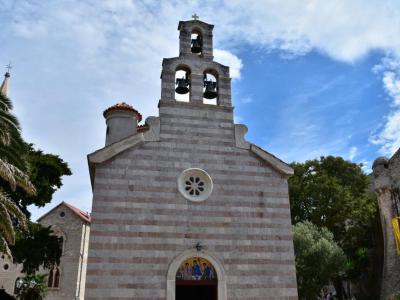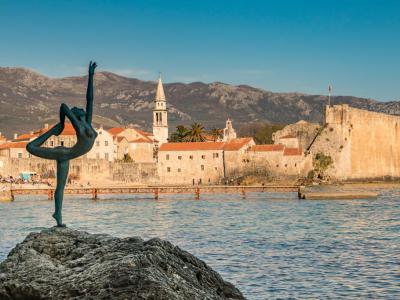Budva Introduction Walking Tour (Self Guided), Budva
Nestled along one of Europe’s most beautiful coastlines, Budva, without doubt, is one of the tourist capitals of Montenegro.
The name "Budva" (or Budua in Italian) carries echoes of the town's ancient past and is believed to have originated from the Illyrian word "Buthos," meaning ox. Dating back to the 5th century BC, the town was originally part of Illyria and later became a Greek emporium during Adriatic colonization. Legend has it that Cadmus, the founder of Thebes in Greece, sought refuge here with his wife Harmonia. In the 2nd century BC, Budva joined the Roman Empire.
Throughout its history, the town saw Byzantine, Slavic, and Avar influences and faced the sack by Muslim Saracens in 841. Doclean kings, Serbian and Zetan nobles, and even Venetian rule played pivotal roles in its development. The Venetians, in particular, fortified Budva with impressive walls against Ottoman conquests, and the Venetian language prevailed here until the 19th century.
Ottoman rule briefly touched Budva in 1572, but it returned to Venetian hands a year later. The Habsburg monarchy took control in 1797, followed by short periods of Montenegrin, French, and Austrian rule. The Austro-Hungarian Empire governed Budva until the end of World War I in 1918, after which it became part of the Kingdom of Yugoslavia.
During World War II, Budva was annexed by Italy but was liberated in 1944, becoming part of the Socialist Republic of Montenegro (within the Socialist Federal Republic of Yugoslavia). In 1979, a devastating earthquake struck, but the town was rebuilt.
Montenegro gained independence in 2006, with Budva emerging as a prominent tourist destination.
One of Budva's historical treasures is Marina Bay, where boats sway gently in the azure waters of the Adriatic Sea. Nearby, the Budva Bell echoes through time, a testament to the town's maritime history.
Religious history is also well-represented in Budva, with the Saint Ivan Church (Crkva Svetog Ivana), the Budva Citadel, and the Church of the Holy Trinity gracing its skyline.
Santa Maria in Punta Church and the Ballerina Statue add a touch of elegance to Budva's landscape, while Mogren Beach invites you to relax and soak up the sun on its pristine shores.
The abundance of local historical landmarks speaks a universal language that captivates all who visit. Blessed with a harmonious mix of stunning nature and impressive cultural heritage, Budva is the right place for a dreamy Adriatic coastline getaway. Just take this self-guided walk and see for yourself.
The name "Budva" (or Budua in Italian) carries echoes of the town's ancient past and is believed to have originated from the Illyrian word "Buthos," meaning ox. Dating back to the 5th century BC, the town was originally part of Illyria and later became a Greek emporium during Adriatic colonization. Legend has it that Cadmus, the founder of Thebes in Greece, sought refuge here with his wife Harmonia. In the 2nd century BC, Budva joined the Roman Empire.
Throughout its history, the town saw Byzantine, Slavic, and Avar influences and faced the sack by Muslim Saracens in 841. Doclean kings, Serbian and Zetan nobles, and even Venetian rule played pivotal roles in its development. The Venetians, in particular, fortified Budva with impressive walls against Ottoman conquests, and the Venetian language prevailed here until the 19th century.
Ottoman rule briefly touched Budva in 1572, but it returned to Venetian hands a year later. The Habsburg monarchy took control in 1797, followed by short periods of Montenegrin, French, and Austrian rule. The Austro-Hungarian Empire governed Budva until the end of World War I in 1918, after which it became part of the Kingdom of Yugoslavia.
During World War II, Budva was annexed by Italy but was liberated in 1944, becoming part of the Socialist Republic of Montenegro (within the Socialist Federal Republic of Yugoslavia). In 1979, a devastating earthquake struck, but the town was rebuilt.
Montenegro gained independence in 2006, with Budva emerging as a prominent tourist destination.
One of Budva's historical treasures is Marina Bay, where boats sway gently in the azure waters of the Adriatic Sea. Nearby, the Budva Bell echoes through time, a testament to the town's maritime history.
Religious history is also well-represented in Budva, with the Saint Ivan Church (Crkva Svetog Ivana), the Budva Citadel, and the Church of the Holy Trinity gracing its skyline.
Santa Maria in Punta Church and the Ballerina Statue add a touch of elegance to Budva's landscape, while Mogren Beach invites you to relax and soak up the sun on its pristine shores.
The abundance of local historical landmarks speaks a universal language that captivates all who visit. Blessed with a harmonious mix of stunning nature and impressive cultural heritage, Budva is the right place for a dreamy Adriatic coastline getaway. Just take this self-guided walk and see for yourself.
How it works: Download the app "GPSmyCity: Walks in 1K+ Cities" from Apple App Store or Google Play Store to your mobile phone or tablet. The app turns your mobile device into a personal tour guide and its built-in GPS navigation functions guide you from one tour stop to next. The app works offline, so no data plan is needed when traveling abroad.
Budva Introduction Walking Tour Map
Guide Name: Budva Introduction Walking Tour
Guide Location: Montenegro » Budva (See other walking tours in Budva)
Guide Type: Self-guided Walking Tour (Sightseeing)
# of Attractions: 13
Tour Duration: 2 Hour(s)
Travel Distance: 1.3 Km or 0.8 Miles
Author: DanaOffice
Sight(s) Featured in This Guide:
Guide Location: Montenegro » Budva (See other walking tours in Budva)
Guide Type: Self-guided Walking Tour (Sightseeing)
# of Attractions: 13
Tour Duration: 2 Hour(s)
Travel Distance: 1.3 Km or 0.8 Miles
Author: DanaOffice
Sight(s) Featured in This Guide:
- Marina Bay
- Budva Bell
- Ruins of Roman-era Necropolis
- Porta di Terra Ferma (Mainland Gate)
- Budva City Walls
- Njegoseva Street
- Budva City Museum
- Crkva Svetog Ivana (Saint Ivan Church)
- Budva Citadel
- Church of the Holy Trinity
- Santa Maria in Punta Church
- Statua Ballerina (Ballerina Statue)
- Mogren Beach
1) Marina Bay
Marina Bay graces the stunning Budva coastline, offering visitors a front-row seat to the Adriatic Sea's crystal-clear waters and panoramic views of the surrounding landscape.
Marina Bay serves as a haven for boating enthusiasts, providing a safe and well-equipped harbor for yachts, sailboats, and other vessels. It boasts modern amenities that cater to both seasoned sailors and tourists.
The harbor's vantage point offers breathtaking sunset views, making it a prime spot for capturing unforgettable moments and enjoying the tranquil beauty of the sea.
The marina occasionally hosts events and festivals, adding to its vibrant atmosphere. These gatherings provide an opportunity for locals and tourists to come together and celebrate the coastal lifestyle.
Marina Bay serves as a haven for boating enthusiasts, providing a safe and well-equipped harbor for yachts, sailboats, and other vessels. It boasts modern amenities that cater to both seasoned sailors and tourists.
The harbor's vantage point offers breathtaking sunset views, making it a prime spot for capturing unforgettable moments and enjoying the tranquil beauty of the sea.
The marina occasionally hosts events and festivals, adding to its vibrant atmosphere. These gatherings provide an opportunity for locals and tourists to come together and celebrate the coastal lifestyle.
2) Budva Bell
On the picturesque backdrop of Budva's old town wall, an impressive bronze bell and an anchor are prominently displayed. The bell sits atop a low, reinforced concrete pedestal, gleaming in golden hues with intricate silver embellishments and crosses. Despite its striking appearance, there is no accompanying information board to explain the bell's significance, adding an air of mystery to the monument.
Montenegro, including the town of Budva, has attracted not only tourists but also numerous film crews over the years. Historical films and episodes often find their captivating settings in this region. In the past, during the filming of one such historical movie in the northern part of Budva's Old Town, a giant prop bell and a genuine anchor were brought in as set decorations. These items seamlessly blended into the city's historical ambiance. When filming concluded, the production crew decided to leave behind these remarkable "props" as a token of gratitude for the warm welcome they received from the city.
Today, the bronze sculptures of 'The Old Bell and Anchor' have become beloved landmarks along the city's embankment near the old town walls. They draw the attention of millions of tourists, adding to the charm of Budva's historic landscape.
Montenegro, including the town of Budva, has attracted not only tourists but also numerous film crews over the years. Historical films and episodes often find their captivating settings in this region. In the past, during the filming of one such historical movie in the northern part of Budva's Old Town, a giant prop bell and a genuine anchor were brought in as set decorations. These items seamlessly blended into the city's historical ambiance. When filming concluded, the production crew decided to leave behind these remarkable "props" as a token of gratitude for the warm welcome they received from the city.
Today, the bronze sculptures of 'The Old Bell and Anchor' have become beloved landmarks along the city's embankment near the old town walls. They draw the attention of millions of tourists, adding to the charm of Budva's historic landscape.
3) Ruins of Roman-era Necropolis
The Ruins of the Roman-era Necropolis in Budva, Montenegro, offer a fascinating journey back in time to the Hellenic and Roman periods. The origins of this remarkable necropolis are intertwined with the construction of the "Avala" hotel, which took place between 1936 and 1938. During this process, archaeologists uncovered a treasure trove of historical artifacts and graves.
The necropolis is divided into two distinct periods. The older section dates back to the Hellenic period, spanning from the 4th to the 1st centuries BC, while the newer portion belongs to the Roman era, ranging from the 1st to the 2nd centuries AD. These two periods provide a glimpse into the changing civilizations that once thrived in this region.
It is estimated that the necropolis served its purpose for over a millennium, bearing witness to the passing of countless generations. Its longevity underscores its historical significance.
The excavation yielded a wealth of artifacts, including gold and silver jewelry, various types of dishes, glassware, ceramics, and even weapons. These precious items provide valuable insights into the daily lives and customs of the ancient inhabitants.
The majority of the discovered artifacts, including precious gold and silver jewelry, ancient coins, pottery vessels, and various metal items like weapons, are currently showcased at the Budva City Museum for public viewing and appreciation.
The necropolis is divided into two distinct periods. The older section dates back to the Hellenic period, spanning from the 4th to the 1st centuries BC, while the newer portion belongs to the Roman era, ranging from the 1st to the 2nd centuries AD. These two periods provide a glimpse into the changing civilizations that once thrived in this region.
It is estimated that the necropolis served its purpose for over a millennium, bearing witness to the passing of countless generations. Its longevity underscores its historical significance.
The excavation yielded a wealth of artifacts, including gold and silver jewelry, various types of dishes, glassware, ceramics, and even weapons. These precious items provide valuable insights into the daily lives and customs of the ancient inhabitants.
The majority of the discovered artifacts, including precious gold and silver jewelry, ancient coins, pottery vessels, and various metal items like weapons, are currently showcased at the Budva City Museum for public viewing and appreciation.
4) Porta di Terra Ferma (Mainland Gate)
Mainland Gate stands as a testament to the town's medieval past and its connection to the Venetian Republic. In the city's early history, there were gates on all four sides of the walled city, including those facing the sea. Over time, the sea-facing gates were sealed off, leaving Mainland Gate as the primary entry point from the western side.
Mainland Gate serves as the grand entrance to Budva from the west. It leads visitors into Njegoševa Street, which is the town's primary thoroughfare. This gateway offers a glimpse into how access to the walled city was tightly controlled during medieval times. Above the gate, an ancient military observation post once stood sentinel. This post played a crucial role in safeguarding the city's security and was strictly off-limits to external disturbances.
Notably, above the unassuming doorway, you'll find the coat of arms of Stara Budva, signifying the Venetian period. This emblem features three eight-pointed stars and the image of a winged lion, the symbol of the Republic of Venice. It stands as an authentic representation of the medieval city of Budva.
Inside the main city gate, a mosaic icon serves as a poignant reminder of a centuries-old tradition. This icon, featuring the Virgin and Christ, once occupied a niche at this location. A perpetually lit lamp marked its presence, signifying the enduring spiritual significance of this spot.
Mainland Gate serves as the grand entrance to Budva from the west. It leads visitors into Njegoševa Street, which is the town's primary thoroughfare. This gateway offers a glimpse into how access to the walled city was tightly controlled during medieval times. Above the gate, an ancient military observation post once stood sentinel. This post played a crucial role in safeguarding the city's security and was strictly off-limits to external disturbances.
Notably, above the unassuming doorway, you'll find the coat of arms of Stara Budva, signifying the Venetian period. This emblem features three eight-pointed stars and the image of a winged lion, the symbol of the Republic of Venice. It stands as an authentic representation of the medieval city of Budva.
Inside the main city gate, a mosaic icon serves as a poignant reminder of a centuries-old tradition. This icon, featuring the Virgin and Christ, once occupied a niche at this location. A perpetually lit lamp marked its presence, signifying the enduring spiritual significance of this spot.
5) Budva City Walls (must see)
The Budva City Walls, also known as the Budva Ramparts or Budva Fortifications, have witnessed centuries of history. The city walls predominantly exhibit Venetian architectural influences, particularly from the 15th century when Budva was under Venetian rule. The Budva City Walls include a series of fortifications, defensive towers, and gates that once served to protect the town from various threats, including pirate attacks and invading armies.
The Budva City Walls encompass the Old Town of Budva, creating a charming ambiance with narrow cobblestone streets, historic buildings, and a sense of stepping back in time.
Climbing the walls and walking along their paths offers scenic vistas of the Budva Riviera and the picturesque Old Town, making it a popular spot for both history enthusiasts and tourists seeking breathtaking views. Narrow passageways and staircases line the fortress walls throughout the Old Town of Budva. One of these entrances to the fortress can be found near the gate opposite the Avala Hotel. To access it, visitors simply need to enter the Old Town, make an immediate left turn, and pass through the summer terrace of the Mozart restaurant.
The fortress wall takes on the shape of a horseshoe, which means that it doesn't completely encircle the Old Town, preventing visitors from making a full circle. Nevertheless, exploring these fortifications offers ample opportunities to admire the intricate brickwork, ancient loopholes, and breathtaking panoramic views of the Adriatic Sea, imposing cliffs, the stunning natural beauty of Montenegro, and the coastal settlements.
The Budva City Walls encompass the Old Town of Budva, creating a charming ambiance with narrow cobblestone streets, historic buildings, and a sense of stepping back in time.
Climbing the walls and walking along their paths offers scenic vistas of the Budva Riviera and the picturesque Old Town, making it a popular spot for both history enthusiasts and tourists seeking breathtaking views. Narrow passageways and staircases line the fortress walls throughout the Old Town of Budva. One of these entrances to the fortress can be found near the gate opposite the Avala Hotel. To access it, visitors simply need to enter the Old Town, make an immediate left turn, and pass through the summer terrace of the Mozart restaurant.
The fortress wall takes on the shape of a horseshoe, which means that it doesn't completely encircle the Old Town, preventing visitors from making a full circle. Nevertheless, exploring these fortifications offers ample opportunities to admire the intricate brickwork, ancient loopholes, and breathtaking panoramic views of the Adriatic Sea, imposing cliffs, the stunning natural beauty of Montenegro, and the coastal settlements.
6) Njegoseva Street
Njegoseva Street, situated in the heart of Budva's Old Town, is a historic thoroughfare that served as a vital route for both residents and traders navigating the town's labyrinthine streets.
As you stroll along Njegoseva Street, you'll encounter a captivating blend of architectural styles, reflecting different periods in Budva's history. From charming stone facades to ornate balconies, the street offers a visual feast for those interested in architecture.
Njegoseva Street is a bustling hub of activity, adorned with various shops, boutiques, cafes, and restaurants. It's the perfect place to indulge in some retail therapy or savor local cuisine.
The street's strategic location ensures that it's not far from Budva's stunning coastline. Visitors can easily access the beachfront, making it a convenient starting point for seaside adventures.
As you stroll along Njegoseva Street, you'll encounter a captivating blend of architectural styles, reflecting different periods in Budva's history. From charming stone facades to ornate balconies, the street offers a visual feast for those interested in architecture.
Njegoseva Street is a bustling hub of activity, adorned with various shops, boutiques, cafes, and restaurants. It's the perfect place to indulge in some retail therapy or savor local cuisine.
The street's strategic location ensures that it's not far from Budva's stunning coastline. Visitors can easily access the beachfront, making it a convenient starting point for seaside adventures.
7) Budva City Museum
The Budva City Museum serves as a custodian of Budva's historical legacy, preserving and showcasing artifacts, documents, and exhibits that illuminate the town's multifaceted history.
The museum boasts a remarkable collection of artifacts that bear witness to the town's Greek and Roman heritage. Among these treasures are exquisite pieces of jewelry, ceramics, mosaics, and glassware, each echoing the craftsmanship of bygone eras.
The museum's archaeological collection is a treasure trove of ancient wonders, with some artifacts dating back to the 4th and 5th centuries BC. In total, it houses an astounding 1,200 objects, each carrying a piece of Budva's story through time.
The museum is situated within Budva's enchanting Old Town, contributing to its historical charm. Its location amidst ancient stone buildings adds to the overall cultural experience.
The museum boasts a remarkable collection of artifacts that bear witness to the town's Greek and Roman heritage. Among these treasures are exquisite pieces of jewelry, ceramics, mosaics, and glassware, each echoing the craftsmanship of bygone eras.
The museum's archaeological collection is a treasure trove of ancient wonders, with some artifacts dating back to the 4th and 5th centuries BC. In total, it houses an astounding 1,200 objects, each carrying a piece of Budva's story through time.
The museum is situated within Budva's enchanting Old Town, contributing to its historical charm. Its location amidst ancient stone buildings adds to the overall cultural experience.
8) Crkva Svetog Ivana (Saint Ivan Church) (must see)
Saint Ivan Church is built upon the foundations of a church that dates back to the 7th century, providing a link to Budva's deep historical heritage. The church, as it stands today, is designed as a three-transept basilica, featuring a distinctive layout with multiple transepts. This architectural style is characteristic of many medieval churches. The façade of the church is adorned with Gothic elements, adding to its architectural appeal and historical character.
In 1867, a belfry was added to the church, contributing to its visual prominence and serving as a significant architectural feature.
Saint Ivan Church houses the revered icon of the Holy Mother of God with Christ, known as Budvanska Bogorodica (Holy Mother of God of Budva). According to legend, the icon's author is believed to be Saint Luke, though experts date it to the 13th century. This icon holds immense cultural and religious importance.
The church is home to various valuable artworks, including a painting of Saint Peter and Paul created in the Venetian school style, icons of Greek origin, and a painting of Sveti Luka, a masterpiece by Anastas Bocaric.
Saint Ivan Church holds immense spiritual significance for the local Orthodox Christian community. It has served as a place of worship, prayer, and religious ceremonies for generations.
In 1867, a belfry was added to the church, contributing to its visual prominence and serving as a significant architectural feature.
Saint Ivan Church houses the revered icon of the Holy Mother of God with Christ, known as Budvanska Bogorodica (Holy Mother of God of Budva). According to legend, the icon's author is believed to be Saint Luke, though experts date it to the 13th century. This icon holds immense cultural and religious importance.
The church is home to various valuable artworks, including a painting of Saint Peter and Paul created in the Venetian school style, icons of Greek origin, and a painting of Sveti Luka, a masterpiece by Anastas Bocaric.
Saint Ivan Church holds immense spiritual significance for the local Orthodox Christian community. It has served as a place of worship, prayer, and religious ceremonies for generations.
9) Budva Citadel (must see)
The Budva Citadel has a rich history that dates back to ancient times. It is believed to have been established by the Illyrians, an ancient Indo-European people, and later developed by the Romans.
The citadel's medieval fortifications were constructed during the Venetian rule in the 15th century. It prominently reflects Venetian architectural influences, characterized by its well-preserved defensive walls, bastions, and towers. The Budva Citadel served as a strategic military outpost, protecting the town of Budva from various threats, including pirate attacks.
Within the citadel, you can find the Church of Saint Ivan (Crkva Sv. Ivana), a small, charming Orthodox church that adds to the historical and spiritual ambiance of the site.
The Budva Citadel is part of the larger Old Town of Budva, which exudes a unique and charming atmosphere. Cobblestone streets, quaint squares, and historic buildings create a picturesque setting that transports visitors back in time.
Climbing the walls of the citadel provides visitors with panoramic views of the Budva Riviera, the Adriatic Sea, and the surrounding landscapes. It's a popular spot for capturing breathtaking photographs.
The citadel's medieval fortifications were constructed during the Venetian rule in the 15th century. It prominently reflects Venetian architectural influences, characterized by its well-preserved defensive walls, bastions, and towers. The Budva Citadel served as a strategic military outpost, protecting the town of Budva from various threats, including pirate attacks.
Within the citadel, you can find the Church of Saint Ivan (Crkva Sv. Ivana), a small, charming Orthodox church that adds to the historical and spiritual ambiance of the site.
The Budva Citadel is part of the larger Old Town of Budva, which exudes a unique and charming atmosphere. Cobblestone streets, quaint squares, and historic buildings create a picturesque setting that transports visitors back in time.
Climbing the walls of the citadel provides visitors with panoramic views of the Budva Riviera, the Adriatic Sea, and the surrounding landscapes. It's a popular spot for capturing breathtaking photographs.
10) Church of the Holy Trinity
The Church of the Holy Trinity is a significant religious and cultural landmark with a rich history and architectural charm. Following the decline of the Venetian Republic in 1797, the Austrian authorities granted permission for the construction of the Church of the Holy Trinity in response to the Orthodox Christian population's request. This project received support from the Bishop of Montenegro. The church's construction was successfully completed in 1804, marking the beginning of its historical journey.
The Church of the Holy Trinity is characterized by its distinctive architectural elements. It boasts a prominent dome and a bell loft housing three bells, which contribute to its visual identity. The church's facade is adorned with intricate detailing, including a rosette positioned above the western entrance. These decorative elements add to the church's aesthetic appeal.
The church's interior features an exquisite iconostasis created by Greek iconographers in the 19th century. This iconostasis is not only a religious focal point but also a significant work of art with considerable artistic value.
In close proximity to the church, visitors can find the tombstone of Stefan Mitrov Ljubisa, a prominent author and politician who hailed from Budva. This memorial serves as a tribute to his contributions and legacy.
The Church of the Holy Trinity is characterized by its distinctive architectural elements. It boasts a prominent dome and a bell loft housing three bells, which contribute to its visual identity. The church's facade is adorned with intricate detailing, including a rosette positioned above the western entrance. These decorative elements add to the church's aesthetic appeal.
The church's interior features an exquisite iconostasis created by Greek iconographers in the 19th century. This iconostasis is not only a religious focal point but also a significant work of art with considerable artistic value.
In close proximity to the church, visitors can find the tombstone of Stefan Mitrov Ljubisa, a prominent author and politician who hailed from Budva. This memorial serves as a tribute to his contributions and legacy.
11) Santa Maria in Punta Church
Santa Maria in Punta is counted among the oldest pre-Romanesque churches in the coastal region of Montenegro, dating back to a remarkable era in history. It carries the weight of centuries within its walls.
Historical records indicate that this church was founded by the Benedictines in the year 840 AD, serving as their cloister. This early religious presence adds a layer of significance to the church's history. Over time, Santa Maria in Punta Church transitioned to the care of the Franciscan order, further shaping its religious and cultural identity.
An intriguing facet of the church's history is its role as the home to the oldest school in Budva. It served as an educational institution where knowledge was imparted, leaving an indelible mark on the town's intellectual heritage.
The church has yielded a trove of ancient tombs, shedding light on the rich history of the region and the lives of those who once called Budva home. For a time, Santa Maria in Punta Church housed an invaluable archaeological collection featuring artifacts unearthed from a nearby necropolis in Budva. These artifacts provided insights into the area's past.
Built in the 12th century in proximity to Santa Maria in Punta Church, the Church of Saint Sava the Sanctifiedit serves as a compelling historical and architectural landmark. What truly captivates visitors is its elevated location, offering panoramic vistas of Budva and its picturesque surroundings, making it a must-visit destination for those seeking breathtaking views of the city.
Historical records indicate that this church was founded by the Benedictines in the year 840 AD, serving as their cloister. This early religious presence adds a layer of significance to the church's history. Over time, Santa Maria in Punta Church transitioned to the care of the Franciscan order, further shaping its religious and cultural identity.
An intriguing facet of the church's history is its role as the home to the oldest school in Budva. It served as an educational institution where knowledge was imparted, leaving an indelible mark on the town's intellectual heritage.
The church has yielded a trove of ancient tombs, shedding light on the rich history of the region and the lives of those who once called Budva home. For a time, Santa Maria in Punta Church housed an invaluable archaeological collection featuring artifacts unearthed from a nearby necropolis in Budva. These artifacts provided insights into the area's past.
Built in the 12th century in proximity to Santa Maria in Punta Church, the Church of Saint Sava the Sanctifiedit serves as a compelling historical and architectural landmark. What truly captivates visitors is its elevated location, offering panoramic vistas of Budva and its picturesque surroundings, making it a must-visit destination for those seeking breathtaking views of the city.
12) Statua Ballerina (Ballerina Statue) (must see)
The Ballerina Statue, sculpted by Gradimir Aleksić, depicts a ballerina in a dynamic dance pose, capturing the fluidity and elegance of ballet.
The sculpture is strategically positioned in a prominent location along the town's scenic promenade, overlooking the sparkling Adriatic Sea. This location enhances the statue's visual appeal and significance as a symbol of Budva's cultural charm. It reflects the appreciation for the performing arts, particularly ballet, and the role of art in enhancing the quality of life in Budva.
The inspiration behind the creation of this magnificent monument traces back to an old legend. It tells the story of a young ballerina and a sailor from Budva who were deeply in love. Every day, the ballerina would come to the shore, gazing out at the vast Adriatic Sea, waiting anxiously for her sailor groom's return. She watched the waves with hope in her heart, believing that they would bring her beloved man back to her side.
However, fate had other plans, as it often does in such poignant tales. Her sailor groom did not return from his voyage, leaving the young bride heartbroken and devastated. Her unwavering faith and dedication to him were so profound that she could not bear the loss. Tragically, the young bride succumbed to a broken heart, her love and devotion to her sailor never wavering even in death. Her story of waiting endlessly for her beloved is both heartbreaking and inspirational.
Visitors to Budva can take a piece of this touching legend home with them, as souvenir shops offer miniature models of the Budva Ballerina Statue.
The sculpture is strategically positioned in a prominent location along the town's scenic promenade, overlooking the sparkling Adriatic Sea. This location enhances the statue's visual appeal and significance as a symbol of Budva's cultural charm. It reflects the appreciation for the performing arts, particularly ballet, and the role of art in enhancing the quality of life in Budva.
The inspiration behind the creation of this magnificent monument traces back to an old legend. It tells the story of a young ballerina and a sailor from Budva who were deeply in love. Every day, the ballerina would come to the shore, gazing out at the vast Adriatic Sea, waiting anxiously for her sailor groom's return. She watched the waves with hope in her heart, believing that they would bring her beloved man back to her side.
However, fate had other plans, as it often does in such poignant tales. Her sailor groom did not return from his voyage, leaving the young bride heartbroken and devastated. Her unwavering faith and dedication to him were so profound that she could not bear the loss. Tragically, the young bride succumbed to a broken heart, her love and devotion to her sailor never wavering even in death. Her story of waiting endlessly for her beloved is both heartbreaking and inspirational.
Visitors to Budva can take a piece of this touching legend home with them, as souvenir shops offer miniature models of the Budva Ballerina Statue.
13) Mogren Beach
Mogren Beach, nestled along the stunning coastline of Budva, is a place where contradictions merge seamlessly, creating an enchanting and unique beach experience. Mogren Beach manages the improbable feat of being both a well-loved destination and a secret hideaway. While it enjoys popularity, its somewhat concealed location lends it an air of seclusion and mystique.
Mogren Beach is divided into two distinct portions, aptly named Mogren I and Mogren II. These two sections are connected by a whimsical wooden bridge and a charming small tunnel. Visitors often settle at Mogren I, where they can claim their spot on the soft sands and bask in the sun's warm embrace.
Mogren Beach, with its blend of popularity and solitude, offers a unique beach experience that captures the essence of Montenegro's contradictions. It's a place where you can soak up the sun, marvel at the natural beauty, and find your own piece of paradise along the Montenegrin coastline.
Mogren Beach is divided into two distinct portions, aptly named Mogren I and Mogren II. These two sections are connected by a whimsical wooden bridge and a charming small tunnel. Visitors often settle at Mogren I, where they can claim their spot on the soft sands and bask in the sun's warm embrace.
Mogren Beach, with its blend of popularity and solitude, offers a unique beach experience that captures the essence of Montenegro's contradictions. It's a place where you can soak up the sun, marvel at the natural beauty, and find your own piece of paradise along the Montenegrin coastline.
The Most Popular Cities
/ view all
